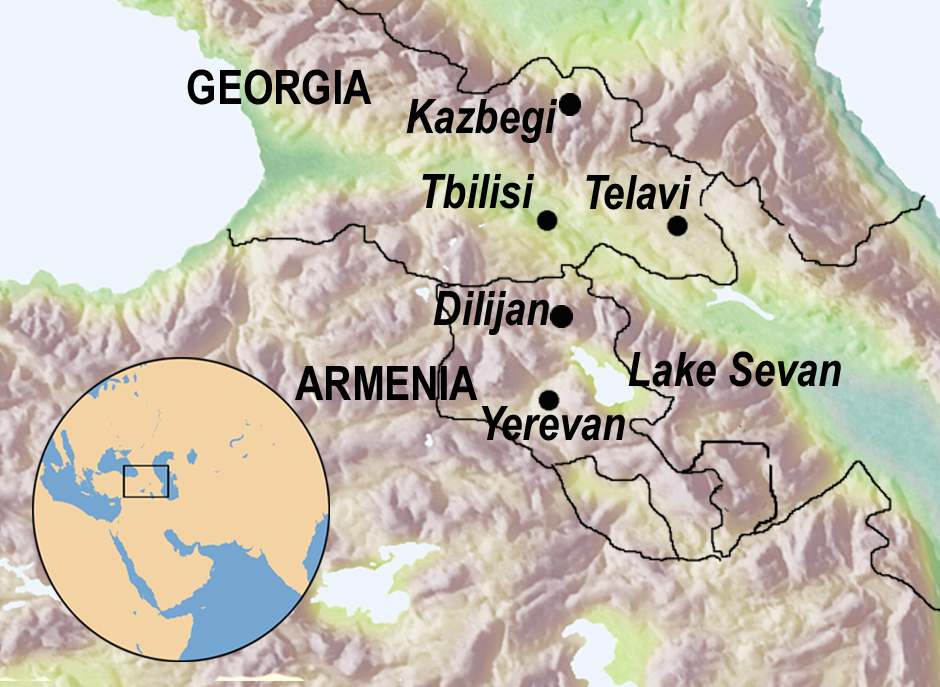
From the legend of the Golden Fleece to the stories of ancient Ararat, Georgia and Armenia share turbulent histories, extraordinary cultural traditions and quite beautiful landscapes. The journey begins in Georgia whose history has been profoundly affected by the country’s adoption of Christianity in the 4th century. In Tbilisi’s superb museums learn more of this fascinating history and how by the 12th century, Georgia’s capital became one of Asia’s most important political, economic and cultural centres. It stood as a key stop on the Silk Road - right on the border between Europe and Asia. Tbilisi’s Old Town, the most ancient part of the city, is renowned for its wonderful mix of cultures. The mosque, the synagogue, the Armenian and Roman Catholic churches mingle harmoniously with the splendid Georgian churches and architecture.
From Tbilisi explore the easternmost part of country – Kakheti – a province of Georgia richest in historic monuments and home to its greatest vineyards. Admire the white-walled, silver-domed Cathedral of Alaverdi with the foothills of the Caucasus rising in the distance. It stands as a powerful symbol of the technical and artistic achievements of the Georgian people. Return to Tbilisi and before heading north explore the ancient capital of Georgia, Mtskheta, where Christianity was first adopted and the town and its historical sites are now listed as a UNESCO World Heritage site.
Travel north along one of Asia’s great roads, the Georgian Military highway which traces a spectacular route across magnificent mountain landscapes to Ananauri, a fortress complex with grand cupolas and soaring towers. After spending two nights amidst the spectacular landscape of the high Caucasus, head south to Uplis-Tsike, a once huge cave city and one of the oldest places of settlement in the Caucasus. It is situated just a few miles out of the town of Gori, birthplace of Stalin.
From Georgia head south into Armenia and spend one night in the delightful town of Dilijan before continuing on to the beautiful Lake Sevan whose colours change with the weather and its own mysterious processes from a dazzling azure blue and a thousand shades in between. Cross the dramatic Selim Pass en route to Yerevan, where the party will spend four nights in Armenia’s elegant capital. Visit the Matenadaran, the world’s largest collection of ancient manuscripts, including works by Aristotle. Enjoy excursions to Geghard, a 10th century monastery hewn out of the rocks, and the Urartu fortress where archaeological excavations have revealed a highly developed civilization. Just north of the capital is the spectacularly situated Amherd fortress surrounded by three ravines at an altitude of 2000 metres on one side of Mount Aragats, Armenia’s highest mountain. From Yerevan return to Tbilisi and en route visit the monastic complex of Haghbat, an excellent example of 10th century Armenian architecture set amongst the beautiful mountains of Alaverdy. Spend a last night in Tbilisi before flying home.
The journey has been organised for the Alumni of Cambridge University but is also open to Alumni of Oxford University and their friends and family. Please note that Distant Horizons has sole responsibility for the operation of this journey. The Universities have no direct control over the operation of any trips.
Maximum Party Size: 20
The trip is currently full. We would of course be very happy to put your name on the waiting list. There is no cost to this and we will only ask for a deposit payment when we can confirm your place(s) and if you still wish to travel at that time. If it is of interest, a similar journey is being planned for a similar time in 2026. Please see the 'Our Journeys' page for more information.
Trip Leader: Dr Alex Koller

Art Historian Alex Koller was born in Vienna and has studied in Vienna, Salzburg and Cambridge. In Vienna he studied Art History, which is one of the cradles of the art-historical evaluation of the architecture of the Transcaucasus. In Salzburg, he gained his first degree in History of Art and Slavonic languages before continuing to Cambridge for a PhD in History of Art from Magdalene College where he also lectured and supervised.
Alex has been accompanying Alumni journeys since 2004 inncluding much of Eastern Europe and Russia including previous journeys to the Caucasus. He is an accomplished linguist and has studied the art and architecture of the Orthodox and other Oriental churches in several countries in Eastern Europe and the former Soviet Union.